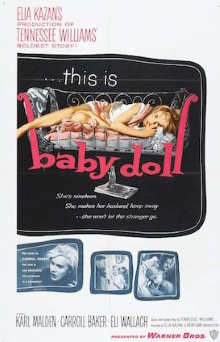Elia Kazan and Tennessee Williams are of course the creative team who made A Streetcar Named Desire. This one was made five years later and it’s immediately apparent from its opening scenes that it shares the same DNA. Unfortunately while there are strong scenes in it and there’s no way that the characters in it can be said to be psychologically uninteresting, this is a case of the whole being lesser than the sum of its parts. None of the characters in it are remotely likable and the whole film oozes with filth and nastiness, yet somehow it is mockingly framed as a comedy. I don’t understand the rationale behind many of the creative decisions here and I don’t like the film. Nonetheless I can recognize the genius of Kazan and Williams in it.
The middle-aged Archie Lee Meighan has been married to “Baby Doll” Meighan for the past two years but he has never slept with her as he promised her dying father to wait until she turned 20. Meanwhile Baby acts like a naive child and even sleeps in a crib in the nursery. She despises Archie Lee especially as his cotton gin business is failing and finds him boorish and unattractive. He has no money to properly renovate the dilapidated house nor even to buy furniture. He blames his turn in fortune on Silva Vacarro, a Sicilian-American who has opened a newer and more modern cotton gin in town. One night, after most of his furniture at home has been repossessed, he burns down Vacarro’s gin. The next day Vacarro is already suspicious that Archie Lee is the culprit and has his cotton sent to his gin. Archie Lee is delighted to get his business and instructs Baby Doll to entertain him. Vacarro, seeing her naivety and youthful beauty, aggressively seduces her in order to extract a confession that Archie Lee was the one who burned down his gin.
I found it a little difficult to understand the milieu in which this story takes place. For example, I wondered if Vacarro is actually Italian or American. I didn’t even understand that ‘gin’ in this context has nothing to do with alcohol but refers to a method of processing cotton. Given that most of the gin workers are black and that Archie Lee is an unapologetic racist, all of these details matter. Archie Lee seems to believe that he can get away with the arson because he is white and is a longstanding member of the local community. Vacarro may be rich but he is a newcomer. A lot of the racism here would lack bite for modern audiences I suspect. Archie Lee’s favorite slur ‘mop’ is no longer in common use and it’s even strange to think of white people being prejudiced against Italians. Still this is a rich and detailed setting, which is why this is a film that deserves to be taken seriously.
On a scene by scene basis, this certainly gets intense at times. Vacarro’s slow seduction of Baby, as he teases her life story out of her and keeps cornering her as she skittishly moves about, is as close as you can get to explicit sex on screen without the actual sex. Archie Lee’s increasingly unhinged rants about Baby wearing too little in the presence of black people and his frustrations about his business failing due to foreigners are something to behold as well. Yet there are parts that seem completely ridiculous and even slapstick. One scene has Vacarro trying to scare Baby into thinking that her house is haunted in the style of old comedies. In fact, the musical cues throughout the film keeps pointing towards it being a comedy which is so tonally inappropriate. I understand that this is a hallmark of Williams’ work but I’m not sure it works well here. Baby’s change in personality later is also confusing. My take on it is that her innocent self is really a kind of defensive mechanism against Archie Lee’s unwanted attention while she is prepared to be an adult woman for Vacarro. It shows that her character is more psychologically complex that she initially seems but I still dislike the film as a whole.
It’s easy to understand why this film is so controversial and it’s interesting to see Kazan and Williams retread some of the same ground as their critically acclaimed earlier work. It’s also fascinating that this film was the origin of the babydoll-style of lingerie. Even so, while this is a film that has some artistic merit, it is not really a good film taken as a whole. It reminds me that creative types have their own obsessions and impulses and sometimes that results in great art. But there are also times when what we get is a dud.
